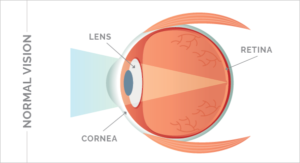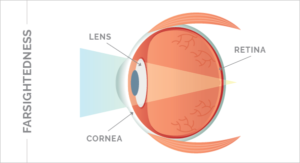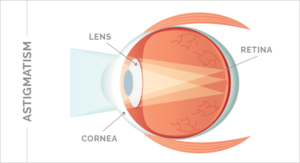
Refractive Errors & You: Nearsightedness, Farsightedness & Astigmatism
If your vision is blurry when you’re not wearing glasses or contacts, you probably have what’s called a “refractive error.” According to the National Eye Institute, more than 150 million Americans have a refractive error of one kind or another. In fact, it’s the most common vision problem. Let’s take a closer look at the causes, types and treatments.
Normal Vision

In eyes without refractive error, sight clarity is achieved by optimal eye size and shape. This allows your eyes to focus light precisely.
Refraction means the bending of light rays as they pass through a transparent object and on to another. In your eyes, it works like this:
- Light comes in through the rounded cornea at the front of the eye.
- The light passes through the pupil and hits the rounded lens, which focuses light rays onto the retina.
- The light reaches the retina, which is the light-sensitive nerve layer at the back of the eye.
So far, so good!
Nearsightedness

If the eyeball is elongated, the light is focused at a point short of the retina. When this happens, you have myopia, or nearsightedness. This means you can clearly see things close to you, but your distance vision is blurry.
Nearsightedness often starts between the ages of six and 14 and worsens through the early 20s. Myopia is becoming more common, too. Scientists think this is because today’s children are exposed to less outdoor light, as they spend more time indoors and on near tasks such as computers and other devices.
Farsightedness

If the eyeball is too short, the light is focused at a point beyond the retina. When this happens, you have hyperopia, or farsightedness. This means you may see things more clearly at a distance (depending on your age) but objects up close become blurry ( this is also dependent on your).
Farsightedness is less common, affecting about five to ten percent of Americans.
In addition, as we get older, the lenses in our eyes become less flexible. This causes almost everyone over the age of 40 to gradually lose the ability to clearly see objects up close. This type of refractive error is called presbyopia. It’s similar to but not the same as farsightedness, and it’s a normal result of aging.
Astigmatism

So, what is astigmatism? It’s a condition in which the curve of the cornea or the lens is more egg-shaped than round, causing light to focus in more than one spot at the back of the eye. This blurs vision at all distances. The more misshapen the curve, the worse the astigmatism.
About one in three people has some degree of astigmatism. It is often congenital but can also develop after an eye injury, disease, surgery or with aging. It often occurs together with nearsightedness or farsightedness.
Treatments for Refractive Errors
The good news is that while refractive errors are quite common, we’ve developed great tools and techniques for getting your imperfect vision as close to 20/20 as possible.
Eye exams
Sharpening your vision—and keeping it that way—starts with comprehensive eye exams at Medical Eye Specialists. Dilating your pupils allows us to clearly see and measure all the parts of your eye and determine the source of any vision problems. Then, when you read the eye chart for us and indicate better or worse for different lens strengths, we dial in the degree of correction you need to achieve clear vision. This changes over time, so regular exams are important.
Glasses or contact lenses (including bifocals, trifocals and progressive lenses)
Both can correct for all types of refractive errors. We’ll help ensure you are wearing the right type for you, and that they fit properly. With contacts, we also want to make sure you’re cleaning and using them safely; if not, serious eye problems can develop.
Surgery
PRK, LASIK and other types of eye surgeries can reshape the cornea to correct for nearsightedness, farsightedness and astigmatism. If you like the idea of clear vision without glasses or contacts, this may be a great choice for you. Schedule a complimentary consultation today.
Cataract surgery can also correct refractive errors. When the eyes’ lenses become clouded—also a normal part of aging—we can remove them and replace them with artificial lenses to improve your vision. If you develop cataracts, your Medical Eye Specialists doctor will talk to you about which intraocular lens (IOL) implants are right for you.
Comprehensive Eye Care
From routine eye care to medical and surgical eye treatment, our ophthalmologists and optometrists are focused on your vision and the health of your whole eye.



